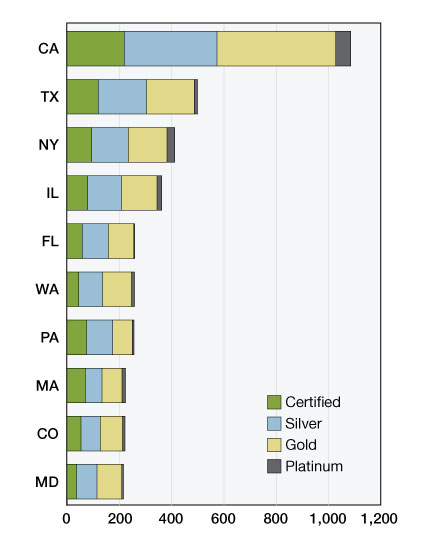LEED-ing the Way
By Jennifer Easton Commercial office has always been a dominant space type among LEED-certified projects. While commercial buildings used to be concentrated in the new construction sector, the USGBC has seen a growing ubiquity of green building retrofits and renovation projects. At the end of last year, we announced that LEED-certified existing buildings began surpassing…
By Jennifer Easton
Commercial office has always been a dominant space type among LEED-certified projects. While commercial buildings used to be concentrated in the new construction sector, the USGBC has seen a growing ubiquity of green building retrofits and renovation projects. At the end of last year, we announced that LEED-certified existing buildings began surpassing new construction projects. This shift indicates that the stigma that green buildings must be built new is disappearing—and with good reason.
With landmark projects like the Empire State Building completing successful retrofits (the project saved $2.4 million in energy costs the year following its LEED Gold certification), many office buildings and skyscrapers around the country are following suit. Plus, projects like the Empire State Building make the case for greening historic buildings: The U.S. Treasury Building in Washington, D.C. (built in 1842) and the Wrigley Building in Chicago (1920), both of which have been certified through LEED for Existing Buildings, also prove that point. These projects demonstrate that historic buildings can be successfully upgraded to sustainable standards without compromising the historic integrity of the building.
Since LEED was launched in 2000, there has been a growing number of space types and sectors apart from commercial office space. For one, data centers are on the rise. This is a really unique space compared to the traditional office building. Data centers are typically devoid of people, save a very small staff, but are massive structures that can have energy needs similar to that of a small town. Companies like Apple have earned as high as LEED Platinum on their data center projects, indicating a real focus on sustainability in this sector.
Another sector experiencing growth is hospitality. This emerging sector has its own set of challenges, very different from that of the data center or the commercial office. Hospitality projects are compartmentalized into individual units housing occupants with differing needs and usage rates of energy and water. Additionally, many hospitality projects include retail and restaurant space. Through updates to the LEED rating system, the USGBC is working to build in specific compliance paths for sectors like data centers and hospitality to create a more applicable and inclusive LEED rating system.
—Jennifer Easton is a communications associate with the U.S. Green Building Council.
(top 10 states by number of certified commercial projects)








You must be logged in to post a comment.